Chromexcel. One of my favorites, and probably my single favorite if I had to choose one. The picture above gives some idea of how long the formula has been around (and this journal is full of different trials and doesn’t even contain the original, standardized recipe). Whether because it’s right, or because we’re just terribly stubborn, we’ve left the processes and formulas for many of our leathers largely unchanged. We have had to substitute some of the components that were traditionally used in small quantities – whale oil was replaced with another marine-creature derived oil, one that’s more available and not controversial.
Chromexcel, or CXL as it’s written in the building, is a combination tanned leather that undergoes at least 89 separate processes taking 28 working days and utilizing all 5 floors of our facility. Needless to say, it’s complicated. For any tannery, the chemistry that transforms salted or cured hides into leather often requires a degree of “cooking.” By cooking I mean there are slight variations that must be managed and corrected from lot to lot. This arises from the fact that we’re taking many component parts, putting them through a multitude of steps, all the while trying to achieve an end result that is as uniform and consistent as possible. There are additional complexities in that we’re taking hides and materials that are naturally occurring – that each hide is in itself unique in that it came from animal as a byproduct of the meat industry is just a single example in a long list. Retannages are derived from tree barks, dyes and stains are derived from naturally occurring pigments, and it’s all mixed and applied using heat, steam, pressure, hands, and time.
The process starts when the hide deliveries come in from one of our domestic suppliers – brined, with the hair on, and folded and packed on pallets. We inspect the shipments, “side” the skins (meaning we cut them in half, as we run half hides not whole hides), and then stage them for dehairing, bating, pickling, and tanning. Dehairing is achieved in large cement mixer type drums, where we actually use a solution to “burn” the hair off all the way to the follicle. Once we begin this process, and continuing through all the processes that follow for the next week or so, we’ve created a perishable product and started an extremely time sensitive chain of events. A power outage, for example, during dehairing would be very bad – there’s nothing to prevent that burn to continue and digest the hide along with the hair (yes, it has happened – think Jell-O).
After dehairing the mixer is “limed” (actually re-limed at this point) to manage the reaction and then drained and washed. All of the water that we use, we treat. We have a fully functioning, EPA compliant, City of Chicago monitored, effluent treatment plant. And, being responsible and ethical producers, we take that very seriously.
After dehairing comes lime fleshing, where the back of the hide is scraped of any unsavory bits. This also serves to open up the hide for the next processes – bate, pickle, and tan. Bating and pickling is the initial preservation step, and serves to prepare the hide for the actual base tannage. In the case of Chromexcel, this is a chrome base, achieved using chrome salts. This is done through lots of what many would think is complicated chemistry demanding specific concentrations, temperatures, run times, and pH levels. This is an around the clock process – our expert mill and mixer operators work shifts all week long beginning Monday morning and ending Friday. At this point, we now have hides that are considered “wet blue,” due to the characteristic blue color that all chrome tannages initially have. The process up to this point is not unique, other than our specific formulations, and the many of tanneries around the world are utilizing similar methods.
This is where it starts to get interesting. Wet blue hides are sorted for initial quality so that the proper “selections” are made – for grain character, weight/thickness, scratches, scars, brands, etc. Next comes retanning, and it’s where the secrets begin. Specific and proprietary mixes of bark extracts and natural agents are used to give Chromexcel, and many of our leathers, its heavy vegetable retannage. The benefit of combination tanning comes from the specific attributes that both chrome and vegetable tanning impart. Generally, chrome tanned leathers yield soft, supple, and durable leathers, while vegetable tanned leathers are round and full feeling, patina well, and are easy to coax into shapes using heat and moisture.
The next step is “hot stuffing” – that is, the impregnation of the hides with oils, waxes, and greases that are solid at room temperature. Stuffing is achieved through the use of steamed mills, and is the process that is responsible for the “pull-up” of this leather. Pull-up is the temporary displacement of these oil and wax blends that cause a lightening of the leather. Our philosophy that you need to use the best components to make the best leather is particularly evident in this department, where we create blends using products like food-grade beef tallow and cosmetic-grade beeswax.

A stuffing mill about to be pulled - the drum is made of wood and the door has been removed to allow the leather to cool enough to be handled.

Chromexcel air drying - this takes up to a week - it's also the best smelling room in the whole building.
Now that we have the canvas ready, we can start the finishing process. Chromexcel receives several hand-rubbed coats of aniline (non-pigmented) finish – this type of dye application allows for even staining of the hide
For the most part, the leather is complete at this point, and it’s ready to be sorted, graded, packed, and shipped. The last step for Chromexcel is coat of Neatsfoot Oil, so when people ask me how to condition this leather, that’s always my first recommendation.

Wooly Chromexcel Belts - Brand new (above), 5 years of wear (below) - wooly is version of Chromexcel with a different stuffing blend.
There are many varieties of Chromexcel at this point – Wooly, Beaufort, Cavalier, Plainsman, Huntsman, Kudu, and Horsefront, to name some. All have been developed with specific uses and attributes in mind, but all share many of the same processes and formulas as the original formula, and all are made by the same skilled and experienced craftsman. I say it all the time, and I can’t say it enough – ultimately the quality of our product relies on our tremendously capable employees.
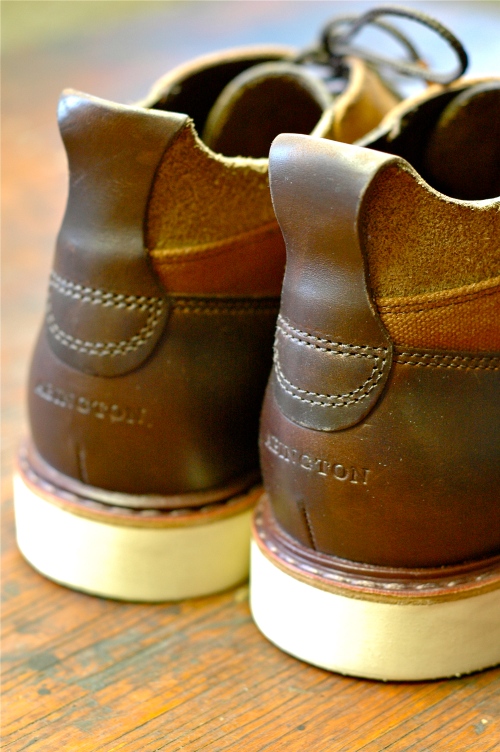
Abington Collection Boots by Timberland - same as the first boot in the post. The single piece pull and "rough out" details are excellent.




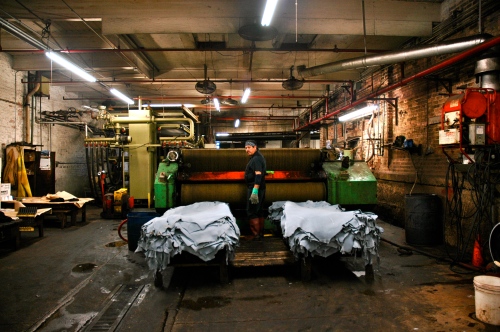
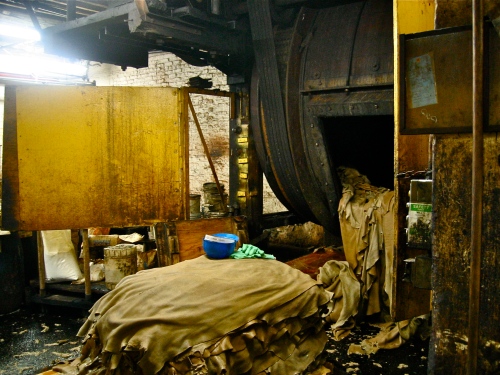



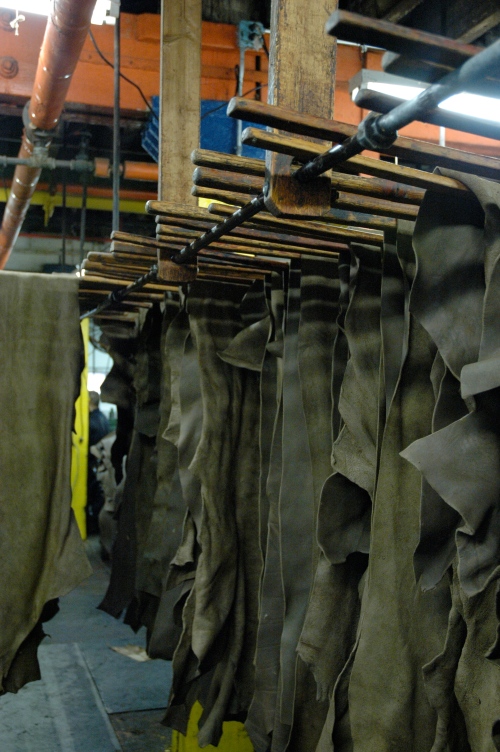


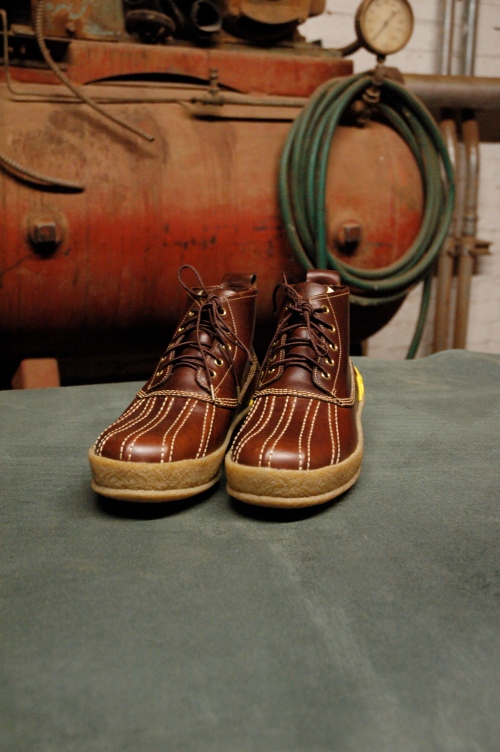



This is so great. This is the kind of thing I would have tried to write if I’d followed up on that interview idea. But that of course would have been secondhand–it’s better coming straight from the source. It’s just fascinating. Thanks for this.
Is it weird that it made me kinda hungry?
Pingback: Chromexcel Leather
Fantastic post! Thanks Nick!
Pingback: Eye Candy: Aero Horsehide Chromexel Jacket « Black and Tanned NY
Are all of your hides from domestic cows? How about the horse hides? I have seen a lot of shoes made with “French calf” do you know of any differences in quality of hides based on location?
Our cowhides come mostly from Iowa, Illinois, Nebraska and Canada. Horshides are from France, Quebec, and Belgium, where horse is still raised as a foodsource.
Sometimes leathers get labels based on how they’re processed – a tannery anywhere could make Waxed French Calf or English Chrome, for example.
There are differences in hides from different places, but mostly these differences can be attributed to how the animal is raised, the type of animal, and the climate.
Thanks a lot for that super in-depth post. Love to read about all this stuff.
Neat belts. Where are they from?
Awesome post, the process is so mind blowing in person, it’s nice to have it now laid out and in order…thanks!
Nick,
Thanks for taking the time to write this article. If only people stop to think about how much effort goes into making good leather!
Thanks to Horween for Chromexel.
Thanks, Sri!
Brilliant article. Please, more. And thank you.
Does shell cordovan get chrome tanned first and then re-tanned using vegetable tanning, or is it just vegetable tanned?
that jacket is Awesome!!!!!
It makes you instantly supercool.
Please make some color charts (chromexcel and shell cordovan) available for us armchair leather goods designers.
I’ve tried a couple of times to make color sheets, unsuccessfully. It’s been impossible to show grain character, pull-up, and color. And then, everyone has a different monitor. I’ll give it another shot…
Pingback: Objects of Affection: Alden x Context Roy Boot « Black and Tanned NY
Do you make shoes out of Bull-Dog hides?
– AG
I have a feeling you know the answer to that, friend! No bulldogs harmed in the making of any our products…
Pingback: Upgrade: Your Everyday Belt « Horween Leather Co.
Pingback: Chromexcel® « Horween Leather Co. « Rider Boot Company
as advice to clean and maintain the quality of the chrome? tks
A damp cloth and a good brushing is the best place to start.
Pingback: Chromexcel® (via Horween Leather Co.) « United Style
Pingback: The Chromexcel Process « Smith + Butler
THOSE BOAT SHOES ARE SMOKIN
Pingback: Technique: Toggling and Drying « Horween Leather Co.
Pingback: NorthSpace » Blog Archive » Horween Leather
I bought a pair of shoes with horween predator leather. Can you give me any information on the predator distinction?
Predator is a waxed and tumbled full grain leather. The wax used on the leather is burnishable and will wear very well over time. This is a chrome tanned leather with a heavy vegetable retannage.
Enjoy!
Thanks! I really appreciate the info and I am thoroughly enjoying the leather. It has a beautiful pull-up.
I really loved the post so I used my Digg account to digg it – should assist you
Fantastic! I love this information. I just bought the Wolverine 1000 Mile boot, now I know why my feet feel so good. 🙂
Thank you for making a quality product in the USA.
One day I will buy shoes with your shell cordovan.
Most people (like me) just don’t have a clue about the process of creating high quality leathers.
Thanks for enlightening us.
– Michael
Beautiful….
Hi~I come from Taiwan.
I bought a pair of Red Wing Beckman series 1910.
http://www.cultizm.com/product_info.php?info=p163_Red-Wing-Boots-9010D-Beckman-Black-Cherry-Featherstone.html
Someone says this early version(19xx) is made of your Chromexcel.
Then the “19xx” change its name to “90xx”. But 90xx is using Featherstone now.
Is this a correct message that you have provided Red Wing with Chromexcel?
Thanks for answering my question!
I do not work for Horween, but as an individual with a store selling Red Wing, Alden, etc for years, I can tell you first hand that yes, the Red Wing 1900 series Gentleman Traveler boots were made with Horween Chromexcel leathers. When Red Wing re-released them as the Beckman boots under the 9000 series, they switched to Featherstone leathers. Both great products. I’d say overall the Chromexcel is more attractive and ages/patinas better, but the Featherstone is incredibly durable and seems to take a beating better than Chromexcel. If only both were offered as options.
Andrew, thanks for the insight and the info!
Thanks for the in-depth information. Definitely helps when choosing a product and or brand.
Pingback: Chromexcel tanned leather… | Triple Stitched
Hello!
Please tell me how i can carry for Kudu Leather on my Alden Indy 404?
It’s a great leather and very oiled,and i don’t now what means it is necessary to use…
Best,
Aleksandr
Hi Nick,
Thanks. i finally fully studied your post after i got ur email.
would like to visit you soon.
I Just purchased the Alden Alden Indy Boot – 403 – Dark Brown Chromexel
Upper – Heavy, full grain brown waxhide leather.
What is the best way to treat this leather. I’d like to have the option of great patina, and dull patina.
Ike
I like Venetian Cream for conditioning and luster, neat’s foot oil is a good option as well.
I’m not familiar with Venetian Cream for conditioning and luster, neat’s
foot oil.
I’m not familiar with the above. Do they have a commercial names. Where can I purchase them.
What about Saphir Renovateur from Rider boots.
While we on the subject of leather treatment, should I treat my Alder Shell cordovan with wax only, or cream (Ron Rider has a Shell specialized cream) as well.
Thank you,
Ike
Neat’s foot and Venetian Cream are sold under those names. You don’t need to use brand specific polish for shoes.
Renovateur is great stuff – it’s relatively expensive compared to the other two options above.
Thank you for all your quick replies. What you’re saying that I can use Renovateur instead of the Venitain cream, or the neat’s foot oil. there is no need to use an additional product like a regular shoe cream on top.
What about Crema Alpina? Is this another pre-conditioner, or a full conditioner.
Can you advice about you Horween Shell Cordovan treatment, Wax vs. Cream?
Thanks,
Ike
What about Montana Pitch Blend for weather proofing Chromexcel Ox Blood leather boots?
I’ve used Pitch Blend before with success. It gives some water resistance, but will add some shine. Try the inside of one of the heels first to make sure you like the look.
true about the shine, but thanks for the response
I just purchased a pair of Alden PTB’s in a light brown CXL. I have Venetian Cream but fear that it (as well as Neatsfoot Oil) will immediately darken the leather.
Should I just get over it and accept a darker color in order to protect the shoes?
Thanks!
Marley
Venetian will darken the leather over repeated applications, but it won’t be too dramatic. Try applying a little bit on the inside heel to see if you like the results.
Marley,
For the Alden Chromexcel® Indy Boot pull up leather, and for the Handsewn Loafers, I’m using exclusively Graisse Medaille D’or from Saphir. I believe it is the best material for a Chromexcel®pullup leather.
-Ike
Pingback: Wolverine 1000 Mile Original - Stilmagazin Forum
Pingback: Makr Carry Goods | Goodstead Blog
Pingback: Oxblood Cardholder – Tanner Goods & Horween : Marrow Magazine
Pingback: Неклассическая обувь - mocassins, top-siders, suede boots, etc
Pingback: Brand Primer: Chester Mox | Aloha Sunday Supply Co.
Hello !
Is Chromexcel a vegetaly tanned leather ? could you light me up on the difference between Chromexcel and vegetaly tanned leather ?
Thanks a lot for your wonderful work, it’s great to see a tanery on the internet 😉
All the best,
Robin
Pingback: CONVERSE FIRST STRING !!! « AVENUE
Robin,
I think Horween has put out a great video, and other material about the process of taking raw leather, and transforming it it into a beautiful Chromexcel Pull-Up finished product. Please I do encourage you to go through the material, if nothing else just because it is your favorite beloved leather.
Best,
Ike
White’s Boots Semi Dress for those weekend days in town. Brown CXL or Brown HorseHide? My daily “office wear” shoes are a variety of Alden’s in Shell #8. Some for over 20 years. Shell is the perfect leather for dress shoes. Looking for the perfect leather for weekends, or the occasional stroll across the log deck, corral, or runway. Thanks for making great stuff that goes into products that can be rebuilt for decades.
I’ve read that neatsfoot oil can damage stitching on shoes, and over time, salts in the oil can build up and dry out the leather. Is there truth to this? Whats your opinion on Pecards leather conditioners for maintaining chromexcel leather?
I’ve heard that also, but I’ve never seen it happen. Chromexcel receives a coat of neatsfoot oil, so it’s not harmful to the leather when used sparingly. Many people like Pecards. It works well, but it’s a little shiny for my taste.
I understand Aero’s FQHH horsehide is essentially Chromexcel SHF (single horse front). Can you please advise if this type of leather requires any treatment throughout usage, particularly for the “vintage” variant? Thanks! Peter
I think Aero uses leathers from a few tanneries, though the leather you’re describing sounds like Chromexcel. It doesn’t require too much maintenance, but you can apply a good quality leather conditioner to areas that appear to be a little dry. Try a little spot first to make sure you’ll like the end result.
! have a pair of natural chromexcel boots, what product can i apply to them to weatherproof them, I’m going on a trip and its going to be raining most of the time
Thanks
I agree with you WRT to the beauty of the leather. I have 3 pairs my self. The best product to care for chromexcel shoes is a Graisse Medallion from Sephire. It is designed specifically for pull-up leather. I believe you can purchase it online from Franco’s http://www.francos.com.
Hi. This process is so great!! I just came here for some information if the chrome excel leather is resistent to water. I recently bought wjk engineer boots in this season, which is made of this leather. Do you think it is good to wear outside when it rains?
Chromexcel is a great foul weather leather. You can definitely wear them in the rain, just allow them to dry naturally (no heat) when you’re done wearing them.
Thanks for the reply. I have another question. I saw Graisse Medallion from Sephire you mentioned in the page. Is it the same as mink oil.? These is similar one in a website, Sephire Korea. I’m sorry it’s Korean. But it says it contains mink oil and seal oil. Can I apply this one to care my boots for waterproofing and maintenance?
Thanks.
http://www.saphirkorea.com/front/php/product.php?product_no=12&main_cate_no=4&display_group=1
“There are many varieties of Chromexcel at this point – Wooly, Beaufort, Cavalier, Plainsman, Huntsman, Kudu, and Horsefront, to name some.” – Could you give us more info on each? I couldnt find any info on the website. I have played around recently making some small leather items, and have fallen in love with Chromexel. I have bought it from Maverick leather, but always jut ordered Chromexel. I didn’t know there are options with in that. Thanks for such a great product.
Thanks for the comment. Here’s a quick breakdown:
-Aniline Chromexcel WP – the classic, hot stuffed pull-up leather
-Beaufort Chromexcel – the same as the above, but with a different oil/wax blend. Designed to be cementable due to less oil.
-Wooly Chromexcel – receives a different stuffing blend with a heavy addition of wool grease (lanolin)
-Plainsman Chromexcel – A duller version with a more pronounced grain character
-Kudu Chromexcel – Plainsman that has been hand-curried (oiled by hand)
-Cavalier Chromexcel – Similar to Beaufort, with a lighter colored base tannage, allowing us to produce brighter colors.
-Huntsman – a.k.a. Waxed Flesh, this version is finished on the flesh side, give it a slicked-down-suede look
-Casual Chromexcel – A mellow (softer) version with less pull-up
-Stampede Chromexcel – Chromexcel with a matte, nubuck finish
-Marine Field Shoe – A natural, flesh out version tanned for the use in boots during WWII (North African Theater)
-Natural M’s Chromexcel – A heavy, mechanical leather used for oil seals
-Glace Chromexcel – A version with a high gloss finish
-Vintage Chromexcel – softer with a slightly pre-aged look
Just about all of the above can be run on either cowhide or horsehide.
Thank you so much for the detail break down of the different types of Chromexcel.
I just ordered a pair of Kudu Ultimate Indy’s and these are my first pair of Alden’s. Can you recommend me how I should go about caring for these? and which products you recommend for cleaning/conditioning/waterproofing? Should I apply anything prior to first wear? Thank you!
Very little maintenance is needed on Kudu Chromexcel. It’s a hand-curried leather, which means it has lots of oil in it already. A damp cloth and a brush is all you will need for care for several years.
Does anyone care to venture a guess about the best way to preserve FQ Horse hide? I have a nice A-2 that I have used neatsfoot on for the past 10 years or so. I have read that it weakens thread. What is the the best option for HH? Is there anything different from Cow/Calf/Steer hide etc? I have 2 pair of HH boots made from North of Cordovan, does the same tips apply as well? Thanks much for the great info! There seems to be so much BS out there, especially concerning anything with Petroleum-based products! Thanks! Clip
Pingback: Tuckshop housing Horween Leathers « Tuckshop & Sundry Supplies
For Wolverine 1000 mile originals, Neatsfoot? How about some obenauf or montana pitch blend for waterproofing?
Pingback: Viberg for WanderWonder (Singapore) | Anchor Division
Hi. I have another question. I saw Graisse Medallion from Sephire you mentioned in the page. Is it the same as mink oil.? These is similar one in a website, Sephire Korea. I’m sorry it’s Korean. But it says it contains mink oil and seal oil. Can I apply this one to take care my boots for waterproofing and maintenance?
Thanks.
http://www.saphirkorea.com/front/php/product.php?product_no=12&main_cate_no=4&display_group=1
For the most part it contain animal oil, same as in Chromexcel.It may contain a small % of mink oil, but it is a different product all together.
I really want to thank you for this detailed write-up! So interesting, and so informative! I’m wondering if the Huntsman is the same as what is sometimes called “Muleskinner”?
If you ever have a chance, I would love to see more write-ups on some of the processes behind, and properties of, the above list of different CXLs, such as Kudu etc.
Awesome blog!
Where can I buy a leather jacket like that. Love tweed inside,
Right here – http://www.aeroleatherclothing.com/
Would love to see some close up pics of the different CXLs that could be used for jacket making.
Thank you for your wonderful blog and company.
Thanks for the informative article and the nice pictures. I have really enjoyed a pair of Alden plain toe bluchers in Chromexcel and have found them very durable. I have even used them for light hiking. I just ordered Alden’s long wing tip shoe in their new brown tan color. Can you tell me if they made with Chromexcel too?
Nick, thank you for the posts and high quality photographs. I like Horween’s leather and Wolverine’s nimble 1000 mile design so well I bought a second pair in tan. I want to ensure the tan pair remains distinctly lighter in tone than the dark brown pair, so what kind of preservative can I use on the tan pair that will darken it the least? I get scuffs on my boots while traveling and I suspect that I should at least put some preservative on the scuffed sections even though the leather arrives new well preserved.
Thanks Nick… your post is very well done. Keep up the good work.
Dave Piper, The Piper Sandal Co. (Horween and only Horween used to make my sandals… have forever… will forever.)
Does anyone know what WP stands for? I understand that MD means mill dyed, which makes the back side the same color as the front, but it also seem to make the surface shinier, correct me if I’m wrong! I am looking for a CXL with a slightly matter surface finish than the “Aniline Chromexcel WP” but that doesn’t change color from front to back..
Thanks! Great article btw
WP is an old designation from the original product name that we won’t remove. Mill dying doesn’t in itself make the surface brighter/shinier, that is usually a function of how the leather is finished. Just about any leather can be finished bright or dull/matte, it just depends on how we treat the final steps of the finishing process.
Wonderful piece of writing …. I love natural products like wood, stone and leather. I am a bit confused about leather when I see a jacket made of 50% leather. It is leather or it is not, right? Maybe I am old fashioned.
I have a full-grain leather motor-jacket and I love it …. it breaths and that is important when living in a country with a average temp of 35 degrees Celsius. But a bit heavy so I bought a light leather jacket also. But I was sweating like a pig in this jacket, so I did some research.
Now, correct me if I am wrong but it seems that nowadays people use leather as base but that is so ugly (or is that de “side” cut off?) you can not use it for a jacket so they impreg the outside to make it look like beautiful leather. In Europe there even seems to be laws what should be called leather and what not. You could impreg for 10% or 20% …. or for 80%, right?
Now I live in a country where the sales people do not give a hoot about laws (if there would be any but I doubt it) or telling lies about their product, so except for buy bloody expensive import leather jackets there seems only to be Chinese made 50% leather jackets.
Would love to be able to see quality pictures of samples laid out side by side of the different CXLs and the other tannages that are available. It would really help in determining what hides to buy.
Thank you for providing the information, it is very helpful.
Pingback: Week In Review ~ 22 September | Carryology
Pingback: Wolverine 1000 Mile Boots
Awesome insight!
What is the significance of the Predator leather in comparison? – how do I best care for these leathers individually? – Thanks
Pingback: GlassTV – Made in America markets create communities of like-minded consumers
Pingback: on Small Businesses » Blog Archive » Made in America markets create communities of like-minded consumers
Pingback: News | Ripple's Web » ‘Made in America’ market movement
Hello there,
Looking for some help as I just purchased a brand new pair of Alden boots in natural CXL.
1 – Should I treat these boots with Saphir Reno or anything else before my first wear?
2 – As I read above, no need to use anything cream or wax products on natural CXL and just use some Saphir Reno, Venetian cream and Sno-Seal if needed and lots of brushing?
3 – What would be a perfect step by step to care for this amazing leather?
example:
3a, before and after each wear: wipe with damp cloth, brush with horsehair brush, buff
3b, once every week use Saphir Reno and repeat the steps above.
Thanks!
SL
1. No treatment necessary before the first wearing.
2. I don’t even use Sno-Seal. A damp cloth, a good brush, and some of the Renovateur or Venetian Cream is all you need.
3. Clean with a damp cloth, allow to dry, brush, apply cream/conditioner, set 10 minutes (or so), brush well, buff lightly with a soft cloth.
You’ll know when you need to clean/condition/buff them. Though, I have some boots that I like beat up and I never do much to them.
Wear them well!
I’m not going to get into step-by-step, but I use for all my Alden’s CXL the Saphir Graise Medaille. Let’s not forget that the CXL has been (heavily) treated with animal oil while the leather was heated. The fat soaked real well into the leather. The Reno is much more delicate, and good for a much more dryer leather.
Good luck with your endeavor.
Thanks a lot for a quick and detailed replies, Horween and Ike.
I guess I’ll skip the initial treatment before the first wear!
Hi. I recently treated (perhaps foolishly) my new indy boots in dark brown cxl with a light application of obenauf’s. It looked great and shiny going on but then absorbed into the leather and all the red tones disappeared. Any advice on how to bring the red up a bit again?